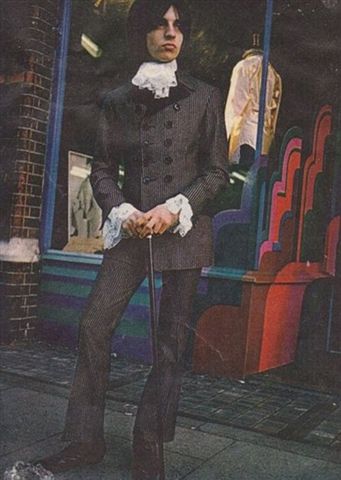Retro Chick is taking a well earned break, but to keep you entertained today’s post comes from Simon Pritchard, an artist specialising in art based on Rock ‘n’ Roll music and pop culture. View his work at Art Beat 64.
For anyone brought up on the British gothic horror films from the Hammer studios in the 1950s and ‘60s or like myself as a kid during TV screenings in the late ‘70s, the first thing that usually springs to mind is Peter Cushing pitting wits against Christopher Lee’s Dracula, staking the odd vampire femme fatale along the way. Breasts and blood were the order of the day to the casual thrill seeker but for the more style inclined viewer Hammer was much more than it’s gore.

The costuming of Hammer from the late 1950s through to it’s demise in the mid ‘70s was second to none often contradicting the studio’s low budgets and appearing more lavish and expensive than they actually were.
This blog’s focus is on Hammers early gothic period from the late ‘50s through the late ‘60s, it’s first wave of greatness.
From the studios first bona fide breakthrough film ‘The Curse Of Frankenstein’ in 1957 the costuming and hair styling of its players often melded together the European Victorian gothic of its settings with contemporary styling of the era in which they were made. Costume designer Molly Arbuthnot designed and ran wardrobe on many Hammer gothic and I believe her styling consciously or unconsciously incorporated elements of late 18th and early 19th century, Victorian opulence and the modern ‘New Look’ of the ‘50s and ‘60s.

Peter Cushing and Hazel Court in Curse Of Frankenstein 1957

hazel court in 'the curse of frankenstein' 1957
Hazel Court’s flamboyant gowns in ‘Curse’ are testament to this surely and the sartorial elegance of it’s male characters reflected the somewhat similar Saville Row upper class Edwardian revival that in turn inspired the working class Brit teddy boy and London spiv culture of the time. It’s no stretch of the imagination to recognise the dandyisms of the teddy boy and American style “zoot suiter†with the sartorial decadence of Peter Cushing’s Victor Frankenstein, something that mirrored the smart and sharp mod dandy fop ethic of the next decade. A point of interest is the ‘Peacock Revolution’ that sprang up in Britain in the ‘50s embraced by middle-class young men seeking to emulate the foppish Edwardian style. Carnaby streets first boutique ‘John Stephen’ catering to dandy affectations opened as early as 1956.
It’s important to note that Hammer Horror arrived just in time in the 1950s, that it’s timing could not have been more poignant is an understatement indeed. Britain’s youth needed something badly to shake off the post war struggles and stiff upper-lipped attitudes of the previous generation; they needed colour, new fashion, new music, thrills and sex.

1960s carnaby street dandy
Rock’n’Roll music from the US was liberating teenagers and upsetting the elders and Hammer inadvertently became the cinematic evil twin to the corrupting onslaught of the “Devils musicâ€.
Their gothic fairytale terrors offered the aforementioned blood and monsters all savagely played out with heaving bosoms in low cut evening gowns and vampire sluts in translucent negligees and wispy nightwear. All this splendour in eye stinging primary colours and evocative pastels. Horror was no longer monochrome and Britain was no longer grey for the nations young.

Suzanne Farmer and Barbarah Shelley in Dracula Prince Of Darkness 1966.
The old guard didn’t know what had hit it, the critics blew gaskets and denounced the debauchery of Hammer but it mattered little, audiences flocked to see the latest Frankensteins, Draculas and assorted monsters and vampires. The small independent studio forever changed the face of not just home grown but horror cinema worldwide. Much respect should be shown to the artistry of it’s craftspeople whose wonderful sets and glorious costumes inspired a struggling post war era and whose beauty is a timeless lush and sexy visual treat more than fifty years later. The Glamour of the Hammer is forever.
Recommended Hammer films for anyone interested
The Curse of Frankenstein [1957]
Dracula [1958]
The Mummy [1959]
Brides Of Dracula [1960]
The Gorgon [1964]
Kiss of the Vampire [1963]
Dracula Prince of Darkess [1966]
The Plague of The Zombies [1966]
Frankenstein Must Be Destroyed [1969]
EDITORS NOTE: You might also try The Best of Hammer Box Set or The Ultimate Hammer Collection (21 Disc Box Set)
to get yourself a good selection of Hammer Films cheaper than buying many of them individually!
2 comments for “Hammer Glamour And Sartorial Chic by Simon Pritchard”